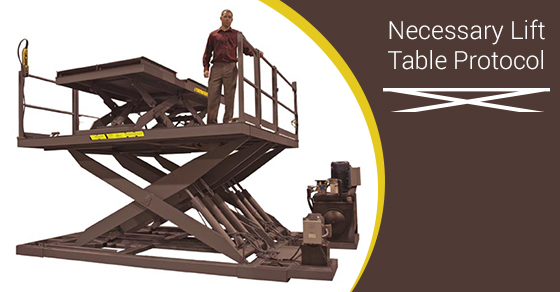Designed to protect workers’ backs, joints and muscles, lift tables are indispensable for transferring and raising large, heavy loads and work pieces. However, if not used properly, this helpful equipment can in fact cause a lot of harm. So, it is vital to observe some common-sense rules and practices when operating lift tables.
-
- Comply with the lift table’s capacity limit and its specific use.
Every lift table has a stated capacity, and you should never use it for loads that exceed that capacity. Every lift table is also intended for specific uses, so don’t use it for any other purposes. And never attempt to modify or change the design of the table yourself.
-
- Ensure a safe area for the lift table.
Make sure that when you are operating a lift table, there are no people close by. The area should also be free of clutter – remove any materials and debris that could cause stumbling or slipping.
-
- Keep your body safe.
First and foremost, wear protective clothing and appropriate safety gear.
Keep your body clear of the load as it is being raised, and never go underneath the table unless the maintenance bar is properly secured.
If you need to lift the table, consult the manual and follow instructions carefully. Do not use fork trucks or other equipment to raise the lift.
Lastly, you should never put your foot or hand in the scissors mechanism.
-
- Report any lift table flaws or bugs.
If you experience any difficulties or snags when operating the lift table, report them right away to your supervisor. If you feel that operating the lift table is causing you some unnecessary physical strain, report this to your supervisor ASAP as well.
-
- Be careful with the electricals.
If the lift table has an electrical cord, it must be kept away from the table when it’s being raised or lowered. The maintenance bar must be engaged and the electrical power turned off before you attempt to disconnect the table’s hydraulic or electrical lines.
-
- Safeguard the load.
Keep the loads uniform for safety and to ensure even wear on the table’s parts.
Never try to move the table when it is raised because the load can fall. You should also not raise the table too fast, and stop raising it if the load becomes unstable.
Do not use the table to raise unbalanced or loosely tied load, and avoid windy conditions when raising the load.
-
- Maintenance checks.
The equipment should be in safe working condition at all time.


